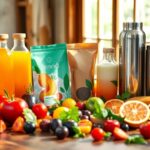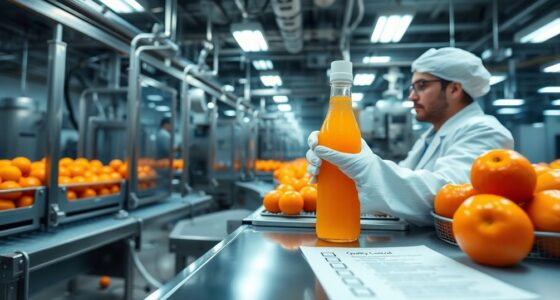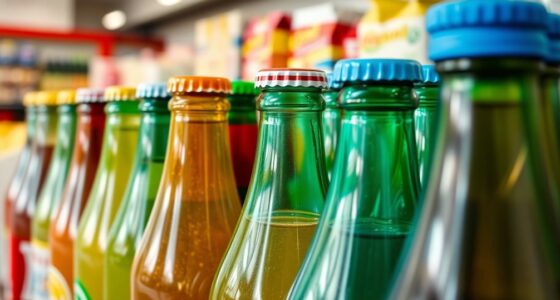Discovering the eco edge in juice packaging means embracing sustainable materials like paper, glass, and aluminum. These options not only reduce plastic waste but also support recycling and circular economies. Innovative designs, including biodegradable materials and smart packaging with QR codes, enhance the consumer experience while minimizing environmental impact. By choosing environmentally friendly packaging, you foster brand loyalty and contribute to a healthier planet. There's more to explore about how these advancements shape the future of the juice industry.
Key Takeaways
- Eco-friendly juice packaging uses recyclable materials like paper, glass, and aluminum, significantly reducing plastic waste and protecting marine wildlife.
- Biodegradable materials, such as plant-based plastics, minimize reliance on traditional plastics and reduce environmental impact during disposal.
- Smart packaging solutions, including QR codes, educate consumers on recycling processes and promote transparency about product origin and freshness.
- The circular economy is supported by using 100% recycled materials, such as rPET, which decreases energy consumption and resource usage.
- Minimalist design principles in packaging reduce material waste, aligning with eco-conscious consumer preferences and enhancing brand sustainability.
The Importance of Eco-Friendly Juice Packaging
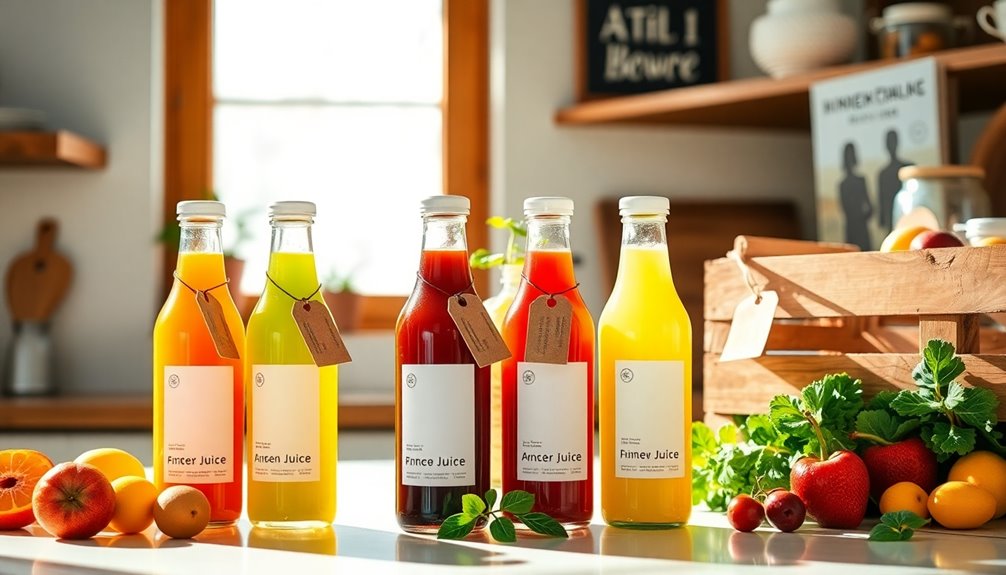
As consumers become increasingly aware of environmental issues, the importance of eco-friendly juice packaging can't be overstated. By choosing eco-friendly packaging, you greatly reduce plastic waste, which is vital given that the average Australian uses 130 kg of plastics annually, much of which threatens marine wildlife.
Utilizing recyclable materials like paper, glass, and aluminum guarantees that your juice packaging can be repurposed, contributing to a circular economy. Additionally, sustainable packaging materials, such as biodegradable options like corn starch and bagasse paper, help eliminate toxic substances and promote healthier production practices.
This shift not only meets your demand for sustainable choices but also enhances brand image and consumer loyalty, as more people prioritize environmentally friendly products when making purchasing decisions.
Key Materials for Sustainable Juice Packaging

Choosing the right materials for sustainable juice packaging can greatly impact the environment. By opting for biodegradable and recyclable options, you contribute to reducing waste and promoting eco-friendliness. Here are some key materials to evaluate:
| Material | Sustainability Features | Recycling Potential |
|---|---|---|
| Paper/Cardboard | Biodegradable, reduces landfill waste | Recyclable |
| Glass | Highly recyclable, reusable indefinitely | 100% recyclable |
| Aluminum | High recyclability, minimal resources used | Closed-loop recycling system |
| Bioplastics | Compostable, made from plant sources | Biodegradable and recyclable |
| Minimalist Design | Reduces material waste | Enhances brand sustainability |
Incorporating energy monitoring features in juice production processes can also contribute to enhanced sustainability efforts.
Innovative Packaging Designs for Juice Products
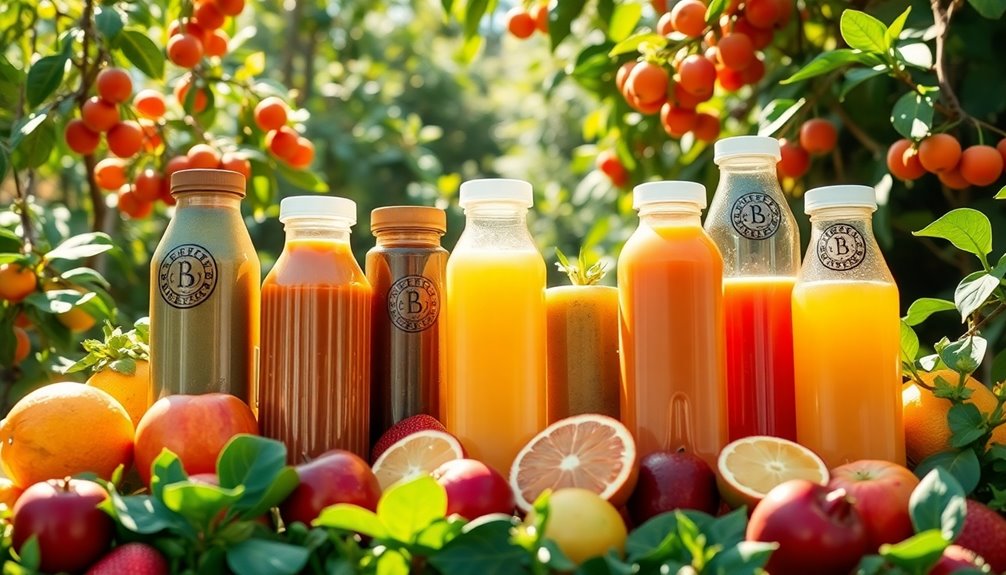
While the demand for sustainability grows, innovative packaging designs for juice products are stepping up to the challenge. These designs prioritize environmentally friendly packaging, offering sustainable alternatives that minimize waste and reduce environmental impact. As brands seek to align with consumer values, many are investing in ecofriendly juice packaging options that utilize materials like recycled paper, biodegradable plastics, and plant-based composites. These advancements not only enhance the aesthetic appeal of juice products but also communicate a commitment to environmental responsibility. By adopting such innovative solutions, companies can significantly lower their carbon footprint and encourage a shift towards more sustainable consumption practices.
- Biodegradable materials like plant-based plastics and corn starch cut down traditional plastic use.
- Smart packaging with QR codes provides recycling info and freshness indicators, encouraging responsible disposal.
- Refillable glass bottles promote sustainability by allowing consumers to refill instead of using single-use containers.
These advancements not only resonate with eco-conscious consumers but also greatly lower climate impact, aligning perfectly with the growing preference for greener choices. Additionally, many juice products are now made from fresh ingredients that enhance both flavor and nutritional value, further appealing to health-focused consumers.
Embracing these innovative packaging designs can help you make a positive difference while enjoying your favorite juice.
The Role of Recycling in Juice Packaging Sustainability
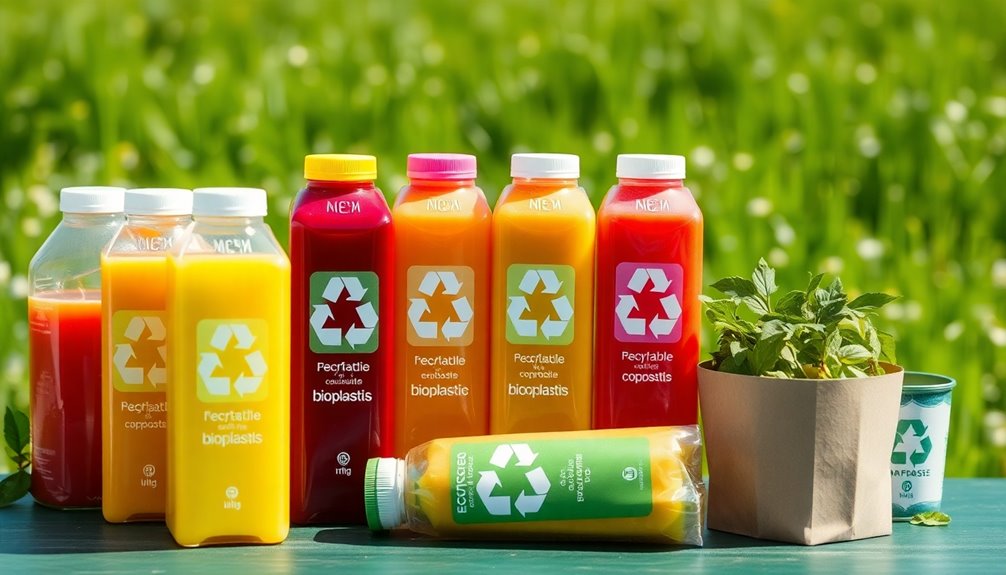
Recycling is essential for achieving sustainability in juice packaging, especially since only 15% of plastic packaging produced annually gets recycled.
To combat plastic pollution, brands are shifting towards more recyclable materials, like beverage cartons made from renewable resources. These cartons have a climate impact 47% lower than traditional PET bottles.
While the recycling rate for PET bottles is higher at 29.9%, using 100% recycled PET (rPET) can considerably reduce energy consumption, as seen with brands like Naked Juice.
Educating yourself on recycling processes is critical; initiatives like PepsiCo's commitment to rPET for its LIFEWTR brand highlight the importance of consumer awareness. Utilizing keyword research tools can help brands identify sustainable packaging trends and consumer preferences.
Embracing sustainable packaging isn't just a trend; it's an essential step towards a greener future.
Smart Packaging Solutions for Enhanced Consumer Engagement

Smart packaging solutions are changing how you interact with your juice.
With interactive QR codes, you can easily access information about recycling and the juice's journey from farm to bottle.
Plus, freshness monitoring technology keeps you informed about the quality and shelf-life, so you always know what you're getting.
Interactive QR Code Features
How can interactive QR codes transform your juice-buying experience?
These innovative packaging solutions not only enhance your engagement but also foster transparency. By scanning the QR codes, you can access essential information about the juice's origin, nutritional content, and recycling instructions, which helps you make informed choices while understanding the environmental impact of your purchases.
- Discover recipes and promotions directly linked to your favorite juices.
- Learn about the sustainable practices your chosen brands implement.
- Access real-time freshness indicators before you buy.
Freshness Monitoring Technology
Interactive QR codes have already begun to enhance your juice-buying experience by providing valuable information at your fingertips.
Freshness monitoring technology is revolutionizing how you engage with juice products. Smart packaging solutions, equipped with gas detection sensors, notify you in real-time about juice quality, ensuring you choose the freshest option.
Additionally, freshness indicators on smart labels visually display the remaining shelf life, minimizing food waste and promoting sustainability.
Augmented Reality (AR) labels offer interactive content on juice freshness and origin, building trust in the brand. Moreover, understanding the benefits of beet juice can encourage consumers to select products that not only taste great but also contribute to their overall health.
The Impact of Juice Packaging on the Environment
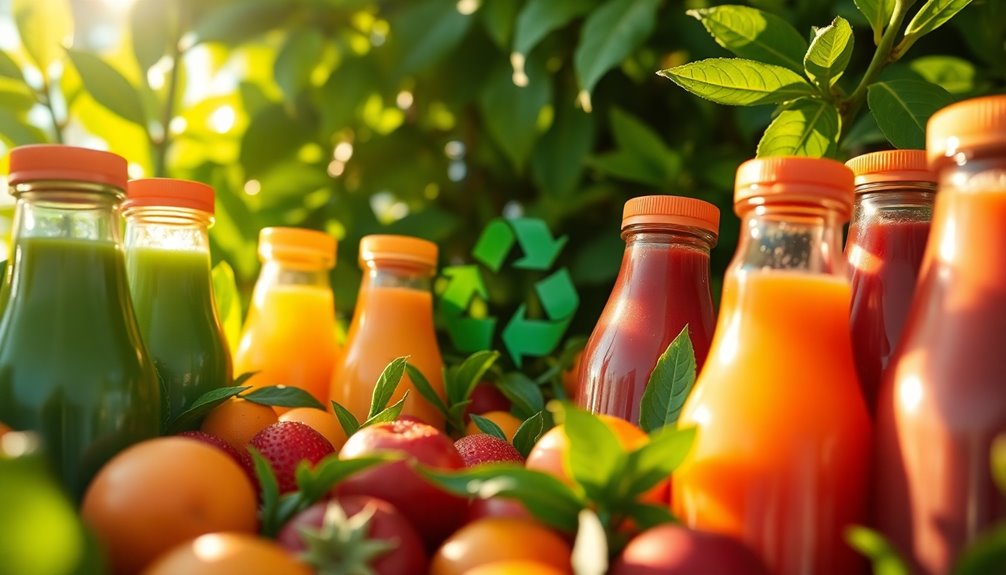
You mightn't realize how much juice packaging contributes to plastic pollution and environmental damage. By opting for sustainable materials and understanding recycling challenges, you can make a difference in reducing our ecological footprint. Additionally, choosing juices that are high in vitamins can support your health while promoting eco-friendly practices. Let's explore how your choices in juice packaging can lead to a cleaner, greener planet.
Plastic Pollution Concerns
As plastic pollution continues to escalate, the impact of juice packaging on the environment has become increasingly concerning.
The alarming statistics reveal that less than 15% of plastic packaging is recycled, leading to immense waste and a growing carbon footprint.
To tackle this issue, you can support brands that explore sustainable packaging options and actively work to eliminate plastic from their products.
- Understand the dire effects of plastic on marine wildlife.
- Recognize the importance of demanding better recycling practices.
- Advocate for brands that prioritize eco-friendly materials.
Additionally, consider the benefits of sustainable packaging materials that can significantly reduce environmental harm.
Sustainable Material Choices
While the quest for sustainable juice packaging intensifies, the choice of materials plays an essential role in mitigating environmental impact. By opting for sustainable material choices, you can greatly reduce landfill waste and resource consumption. Biodegradable materials, like corn starch and bagasse paper, decompose within weeks, while recyclable options such as glass and aluminum support a circular economy.
| Material Type | Benefits |
|---|---|
| Biodegradable | Decomposes quickly, reducing waste |
| Recyclable | Indefinite recycling without quality loss |
| Plant-based Plastics | Lower impact than traditional plastics |
Eco-friendly designs that minimize excess materials resonate with conscious consumers, enhancing brand loyalty in the packaging industry. Making these choices is essential for a sustainable future. Additionally, using recyclable materials can significantly reduce the carbon footprint associated with production and disposal.
Recycling Challenges and Solutions
Recycling juice packaging presents significant challenges that directly impact the environment, especially given that the recycling rate for plastics was a mere 9.1% in 2015, according to the Environmental Protection Agency.
With less than 15% of plastic beverage packaging being recycled, there's a clear need for improved initiatives.
However, there's hope:
- The recycling rate for PET bottles is higher at 29.9%.
- Companies like PepsiCo are pushing for a circular economy to enhance recyclability.
- Recyclable aluminum packaging is gaining popularity as a sustainable alternative. Additionally, the adoption of strong encryption standards in digital transactions can help reduce the environmental impact associated with fraudulent activities, further supporting sustainability efforts.
Industry Trends in Sustainable Juice Packaging
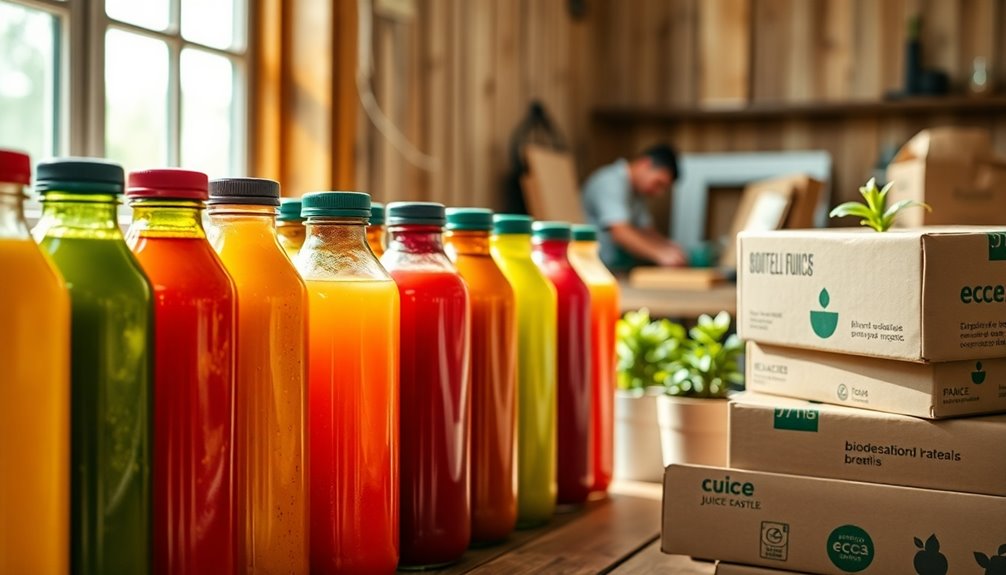
With sustainability becoming a priority for consumers, the juice packaging industry is rapidly evolving to meet these demands. Brands are increasingly adopting 100% recyclable materials, like PepsiCo's commitment to using recycled PET for its LIFEWTR brand.
A significant trend is the shift towards plant-based materials, such as sugarcane-based polyethylene, which reduces reliance on fossil fuels. Minimalist design principles are also gaining traction, eliminating unnecessary components and cutting down on waste.
Additionally, aluminum packaging is on the rise due to its lightweight, durable nature and infinite recyclability. Innovations like smart packaging solutions with QR codes provide recycling information, engaging you in responsible disposal practices.
These trends reflect a growing commitment to sustainable packaging in the juice industry.
Collaborations Driving Innovation in Eco-Friendly Packaging

As the demand for eco-friendly packaging grows, collaborations among industry leaders are driving innovative solutions in the juice sector. Partnerships like those between PepsiCo and Stora Enso are creating packaging made from 100% recycled materials, markedly cutting down on virgin plastics.
Similarly, Elopak and Stora Enso's Naturally Pure-Pak® carton showcases sustainable materials like unbleached paperboard.
These collaborations focus on:
- Developing plant-based plastics and biodegradable films
- Lightweighting packaging to reduce environmental impact
- Educating consumers on recycling practices with initiatives like How2Recycle labels
Together, these efforts by packaging manufacturers not only promote sustainability but also guarantee the responsible use of natural resources, paving the way for a greener future in juice packaging. Additionally, the shift towards renewable energy sources in manufacturing processes further enhances the sustainability of packaging solutions.
Frequently Asked Questions
What Makes Packaging Eco-Friendly?
Imagine unwrapping a gift that doesn't just thrill you but also Mother Earth.
Eco-friendly packaging's magic lies in its materials—think recyclable paper, glass, and plant-based plastics. These choices minimize waste and promote sustainability, making you feel good about your purchase.
Plus, minimalist designs cut down on excess, while smart features like QR codes keep you informed.
What Is the Most Eco-Friendly Drink Packaging?
When you're looking for the most eco-friendly drink packaging, consider glass, aluminum, and biodegradable materials.
Glass can be recycled endlessly without losing quality, while aluminum is lightweight and recyclable multiple times.
Biodegradable options, like plant-based plastics, decompose naturally, reducing waste.
Additionally, using packaging made from recycled materials, such as paperboard, can greatly lower your carbon footprint.
Choosing these options helps promote sustainability and protects the environment for future generations.
How Do You Make Packaging Eco-Friendly?
To make packaging eco-friendly, you can start by choosing biodegradable materials like paper or corn starch that break down naturally.
Incorporating recyclable options, such as glass or aluminum, helps promote a circular economy.
Keep your designs minimalist to reduce waste and appeal to eco-conscious consumers.
Additionally, consider using smart packaging with QR codes for recycling info and implement refillable options to minimize single-use plastics, fostering a sustainable culture among your customers.
What Are the Eco-Friendly Packaging Solutions?
Ever thought about how your choices impact the planet? Eco-friendly packaging solutions are all around you!
You can opt for biodegradable materials like corn starch or bagasse paper, which break down quickly. Glass bottles are another great choice, as they're recyclable and maintain quality.
Aluminum cans are lightweight and endlessly recyclable. Plus, using paperboard from post-consumer waste conserves resources.
Embracing these options helps you make a positive difference for the environment!
Conclusion
In the quest for sustainability, think of juice packaging as a tree: the stronger its roots in eco-friendly materials, the more it can flourish. By choosing innovative designs and embracing recycling, you're not just sipping juice; you're nurturing a greener future. Just as a tree provides oxygen and shade, your choice in packaging can help protect our planet. So, let's raise a glass to eco-conscious choices that make a lasting impact—because every little bit counts!
Cindy thoroughly researches juicing trends, techniques, and recipes to provide readers with practical advice and inspiration. Her writing style is accessible, engaging, and designed to make complex concepts easy to understand. Cindy’s dedication to promoting the advantages of juicing shines through her work, empowering readers to make positive changes in their lives through the simple act of juicing.









